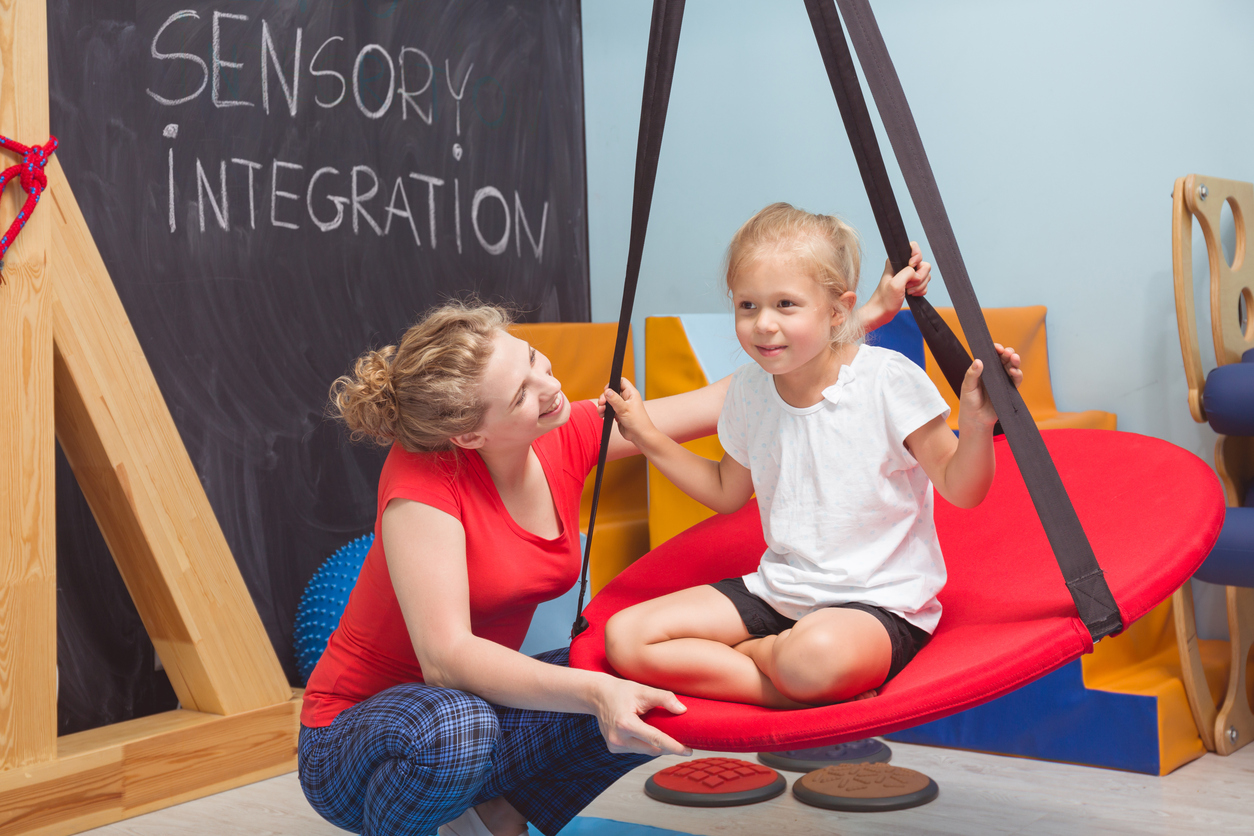
Therapy Tips
The 10 Best Benefits of Sensory Swings
From the time they are in utero, kids’ bodies and brains are developing from the movement they experience. Whether it’s flipping around in amniotic fluid, toddling around as a new walker, jumping on a trampoline, or swinging on the backyard playset, the brain is interpreting movement through its vestibular sense. While most people are familiar with the five senses, the sense of movement (or vestibular sense) is unfamiliar to most parents. The vestibular sense gives a child information about where their body is in space, if they’re moving or still, how quickly they’re moving, and in what direction. Vestibular receptors are located in your inner ear and are activated by the fluid in the ear canals moving as you move. This allows your brain to detect changes in head position to know whether you are moving with or against gravity. These receptors give your body information on where you are in space so you can be safe while navigating through your environment. With a well-developed vestibular sense, your child develops eye/head coordination, muscle tone, balance, and bilateral coordination. Think about all that your child will do as they grow - catch a ball, zip a coat, cut with scissors, copy from the blackboard in school, ride a bike, play a sport - without a developed vestibular sense, these activities would be a challenge!Swings for Vestibular Input
If you’re lucky enough to live in a sunny, warm climate year-round, it’s easy to find outdoor activities that provide vestibular input. Running, biking, climbing, jumping, swinging, and sliding are all fun ways to provide movement opportunities. For some kids who need more intensity of sensory input, or for those of us who are limited by variable outdoor weather, sensory swings are crucial to providing necessary vestibular stimulation all year round. When you can’t provide your child with outdoor vestibular activities, there are alternatives you can add to your play space indoors. Ideally, a sensory swing allows for rotational movement (in all directions) as well as linear movement (back and forth, side to side). Some swings even have a vertical component that allow for up/down bouncing as you swing!10 Benefits of Sensory Swings
- The vestibular sense informs body awareness, safety, muscle tone, balance, and coordination.
- Different types of swings target specific vestibular receptors through different movement patterns: vertical - up/down linear - side/side rotary - all directions The addition of a rotational safety device such as this one from Southpaw allows for movement in all directions and must be added to a fixed mount if you intend to allow for spinning.
- Swings can challenge core strength, balance, righting reactions, and motor skills in different ways, depending on the design you choose. Using swings within therapeutic activities can build these skills in novel, fun ways.For example, a trapeze swing challenges upper body strength but add a crash mat and now you’re challenging timing skills to swing, release, and crash onto a target! Change that simple trapeze into a rope swing style and add a rotary component to the same activity.Another example is using a platform-style swing that challenges balance in a seated position. Swinging and throwing beanbags to a target will help with visual motor, timing, and righting reactions. Use that same swing and activity while lying prone on your belly and see how you can challenge muscle strength and endurance to hold yourself up against gravity!
- Some swings allow for combined vestibular input like this Frog Swing or this Moon Ball Swing. Sometimes you can simply add a vertical stimulation device to turn your favorite swing into a combined input swing. Some kids tolerate combined-input swings better because of the additional proprioceptive input.
- 15 minutes of swinging can have effects on the brain for up to 6-8 hours! Consult your occupational therapist to better understand how to monitor and include spinning in controlled doses!
- Swings allow for varied intensity of movement that may be needed for kids who under-respond or over-respond to vestibular input. The ability to meet individualized movement needs depends on the type of swing you choose: rotary swinging and inverted or upside down movement is the most intense! Linear movement (like jumping or bouncing) is the most tolerated vestibular input because it combines proprioceptive input as well. Predictable, rhythmic swinging promotes calm and organization while unpredictable, arhythmic swinging is alerting.
- The vestibular system is closely linked to the visual system, so improvements (or deficits) in processing are often noticed in both areas. It is common to address visual processing issues with a vestibular or movement component because we use functional vision while our bodies move to inform our body awareness. Sensory swings challenge and develop the functional use of vision by allowing the use of vision to see while moving, or give kids the option of being completely immersed in a swing and eliminating visual feedback. The pod swing is an example of a swing that can be used with or without vision.
- Installing a sensory swing in your home can be as simple as finding a spare doorway, setting up a pop-up tripod stand, or recruiting a handy friend to drill into a ceiling beam. For more information on swing installation, check out Southpaw Enterprises.
- Sensory swings can support sensory diet planning for self-regulation purposes. Whether the intention of your sensory diet is to calm and reorganize, or alert and stimulate, there is a sensory swing that can meet your child’s needs.
- Swings are fun! The possibilities for therapeutic activity with swings are inspiring and endless!



